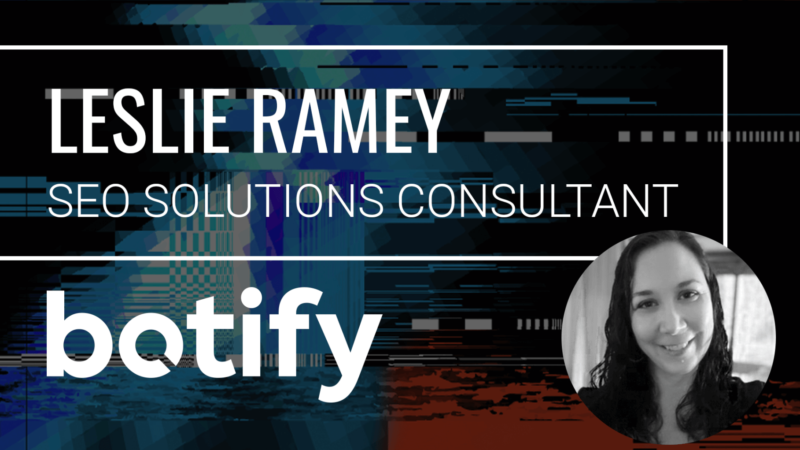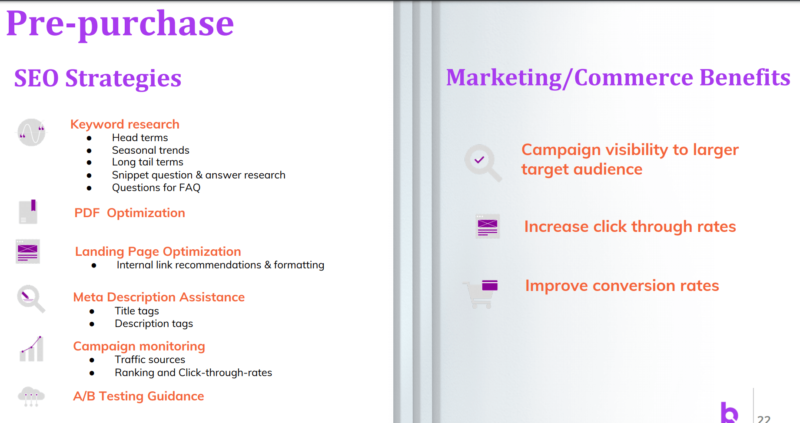Why marketers should break SEO strategies into pre- and post-purchase
In the end, it’s about using the right search data to speak to customer at the right stage in their journeys.

Acquiring search data is not a terribly hard part of an SEO’s job. From the platform-based tools that give marketers the ability to see how their site rankings perform to a range of third-party tools that dig deeper into the data to understand intent and customer lifecycle, there are many ways marketers gather data on how their customers are behaving.
“But how can we then take information that we’ve acquired and then apply it to our strategies from an SEO strategy standpoint as well as from a marketing standpoint?” said Leslie Ramey, SEO Solutions Consultant at Botify.
One approach she advocates for is breaking the approaches down into one bucket for pre-purchase tactics and another for post-purchase.
Before the sale
“During the pre-purchase phase, there’s a lot of information that consumers are looking for,” said Ramey, speaking at SMX Next. “They want to know everything they can possibly know.”
For example, consider a customer who is searching on topics related to kitchen remodeling.
Watch Botify’s SMX Session: SEO and the Evolution of the Customer Journey
“They’re going to start thinking about what their dream kitchen looks like, what are my countertops, what flooring,” she said. Understanding what those queries look like gives marketers an opportunity to create content that matches.
“Some of that’s going to be really important buying guides,” she said. “FAQs are really important in that pre-purchase stage because they help me know what questions I need to ask before I make that purchase.”
With Google featuring direct answers in the SERP via featured snippets, creating content that may be featured there creates an enormous amount of trust with your potential customers because they see you not only as a provider of a product or service, but as an expert.
Another important pre-purchase optimization teams sometimes overlook is PDF optimization. Marketers often create numerous guides, white papers, fact sheets and more for customers that can get lost in search if not optimized. “Now you’re creating it for a larger target audience so you may not even have thought about before,” Ramey said.
Landing page optimization is another critical operation to execute in the pre-purchase stage.
“Here it’s really about internal link recommendations and formatting,” she said. While one department may have decided to put certain links on a landing page, the SEO team will have a better idea which links could actually hurt search performed and no index those. “Just having those constant communications can go a long way and making sure you’re moving in the right direction.”
Other pre-purchase strategies include refining of meta descriptions, titles and more to better align with the search data.
Lastly, the pre-purchase stage is the right time to set up your campaign monitoring structure and to set up and A/B testing guidance.
“When we implement all of these changes we can start to see some really great benefits,” she said. “One is campaign visibility to a larger target audience. If you create collateral, isn’t it better to reach as many people as you possibly can? We can do that by optimizing this content.”
“And you can increase your click-through rate, making sure that you’re not only showing in the right position, but the terms that are showing up in search result page for your title your meta descriptions are appealing to consumers,” she said.
“And of course we can help improve conversion rates because of that. When we know where people are coming in and how we can target that we can increase the value of the users coming in those are more likely to convert than a person that is still kind of in the dreaming phase.”

After the sale
Here’s perhaps a no-brainer that bears repeating: The sale doesn’t mark the end of a relationship, but rather the beginning. In terms of search, buyers may still have tons of questions about using, or troubleshooting, your product or service. Like in the pre-purchase stage, that is an opportunity to create content that answers those questions.
“Monitor key phrases to understand customer reaction. Are they saying things that are positive or negative within your search console that you’re seeing search results coming up for you? Are there ways for you improve your product or your service based on this information?”
“In addition to answering those questions, we also have to pay attention to customers writing reviews and comments and really turning these people into advocates and brand ambassadors for us,” Ramey said. That includes leveraging that content for social media, or launching “stay connected” campaigns on either social media or via email.
At the same time, marketers have an opportunity to take that excitement and affinity for their products and convert those customers again into things like add-ons and accessories.
“Once they’ve caught in and they’ve learned that they loved your brand, we should expect there to be more brand loyalty so we should expect to see an increase in brand queries coming up for your site,” said Ramey. “Paying attention to those are going to be really helpful to let you know that you’ve created sentiment and you’ve created value that they’re excited about.”
Lastly, look at your guidelines and best practices around user-generated content to maximize this post-purchase stage.
“If you put five reviews on a page you’re going to have a much more successful then you only have two reviews,” she said. “You can start working with your teams to generate those five reviews, doing outreach and then you move on to your next product. This is going to allow you to increase visibility across many of your products much faster.”
Overall, with post-purchase strategy “we’re talking about improving your future campaign performance,” said Ramey.
“Let’s learn from our mistakes, let’s learn from our wins, and let’s replicate that so that every time we create a campaign and every time we start working on these things, they only get better with time.”
Contributing authors are invited to create content for Search Engine Land and are chosen for their expertise and contribution to the search community. Our contributors work under the oversight of the editorial staff and contributions are checked for quality and relevance to our readers. The opinions they express are their own.
Related stories